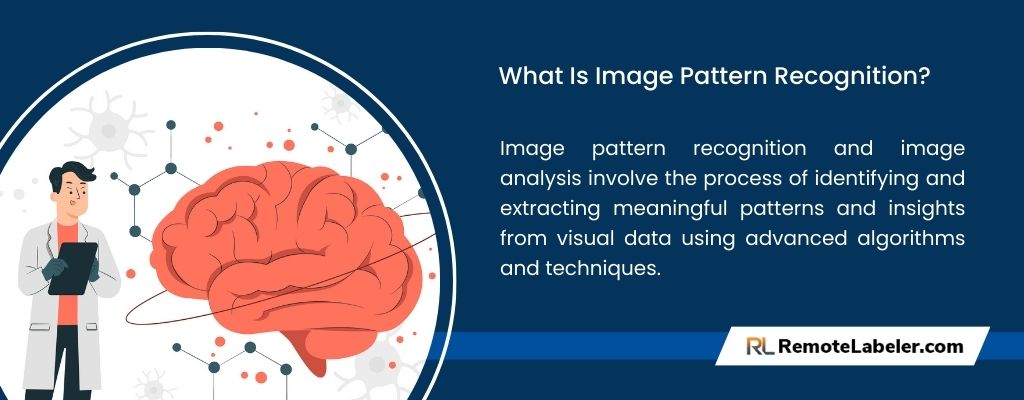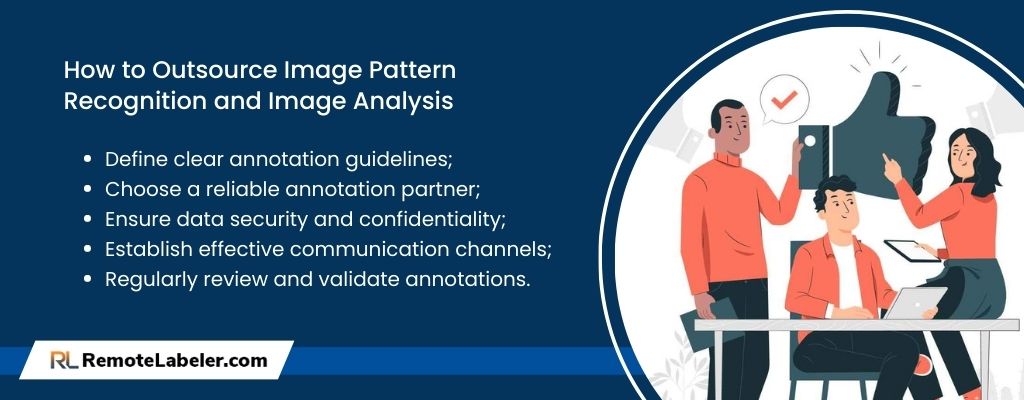In our increasingly digital world, the importance of image pattern recognition can hardly be overstated. As an essential component of many technological solutions, it enables machines to decipher and interact with the world in incredibly sophisticated ways. Image pattern recognition plays a vital role in numerous fields, from enhancing medical diagnostics to enabling the functionality of autonomous vehicles. Its successful implementation hinges not only on advanced algorithms but also on the quality of data collection and labeling.
As the world continues to generate vast amounts of visual data, the complexity and magnitude of these tasks have grown exponentially. It requires significant resources, including advanced technologies and specialized expertise, to effectively carry out image pattern recognition and pattern recognition image analysis. Given these requirements, it’s not surprising that many organizations, from startups to large corporations, opt to outsource these tasks.
Outsourcing can present an efficient and cost-effective solution, allowing companies to access the specialist skills and resources they need without the associated overheads. However, the process is not without its challenges. In this guide, we’ll delve into the steps you can take to effectively outsource your image pattern recognition and image analysis tasks, from understanding your requirements to selecting the right service provider.
Understanding Image Pattern Recognition and Your Requirements
Image pattern recognition forms the crux of numerous applications that aim to decode the world around us in a more insightful manner. This technology is all about finding and recognizing patterns within images, a process which sits at the intersection of pattern recognition and image analysis.

Pattern recognition and image analysis form the cornerstone of many machine learning and artificial intelligence applications. They enable machines to ‘learn’ from visual data, in much the same way humans learn from seeing and understanding the world around them. By recognizing patterns in images, these systems can identify objects, classify them, and even predict future patterns.
But to successfully outsource these tasks, it’s crucial to understand your requirements thoroughly. These can be broadly divided into:
Type of Images: The kind of images you will be working with can greatly influence the choice of your service provider. Are these medical images, satellite images, photos from social media, or another type? The content of the images can influence the pattern recognition image analysis approach.
Specific Patterns to Recognize: What patterns are you interested in? Faces, handwritten text, specific objects, or certain anomalies? The desired patterns should be defined precisely to build an accurate recognition system.
Accuracy Requirements: Define the level of accuracy you aim to achieve. Higher accuracy may require more sophisticated techniques, more processing power, and potentially more time and resources.
Data Volume: The amount of data you have for training and the data you expect to process regularly can impact your choice of outsourcing partner. Larger data volumes may necessitate more robust systems.
By clearly understanding and defining these requirements, you can ensure that you select the most suitable service provider for your image pattern recognition and image analysis needs.
Pattern Recognition and Image Analysis: Choosing a Reliable Service Provider
Choosing a reliable service provider with expertise in pattern recognition and image analysis is an essential step in your outsourcing journey. It’s important to remember that the service provider will be a crucial partner in your project’s success. Here are some key factors to consider when making this important decision:
Technical Expertise: The service provider should have proven expertise in image analysis and pattern recognition, particularly in areas relevant to your project. Look for providers with experience in implementing machine learning pattern recognition techniques, which are often more sophisticated and accurate than traditional methods.
Experience in AI: Given the increasing convergence of pattern recognition and artificial intelligence, providers with experience in pattern recognition in artificial intelligence will likely be more capable of delivering cutting-edge solutions. This includes understanding how to leverage AI technologies to improve the efficiency and accuracy of pattern recognition tasks.
Relevant Industry Experience: Providers with experience in your specific industry will be better able to understand your unique requirements and challenges. They will also likely be more familiar with the regulatory environment and other industry-specific considerations.
Quality Assurance Procedures: The provider should have robust quality assurance procedures in place to ensure the accuracy and reliability of their work. This includes procedures for validating the results of pattern recognition tasks, as well as for continuously improving and updating their models based on new data.
Data Security Measures: Given the sensitive nature of much of the data used in pattern recognition and image analysis, strong data security measures are a must. This includes encryption, secure data storage and transmission methods, and regular security audits.
Project Management Capabilities: The provider should have strong project management capabilities to ensure that the project stays on track. This includes clear communication channels, regular updates, and the ability to effectively manage resources and timelines.
In summary, the ideal service provider for your project will combine technical expertise in machine learning pattern recognition and pattern recognition in artificial intelligence, with relevant industry experience, strong quality assurance procedures, robust data security measures, and effective project management capabilities. This will ensure that your project is not only successful but also delivers the maximum value to your organization.
Tips on How to Outsource Image Pattern Recognition and Image Analysis
Outsourcing image pattern recognition and image analysis is a strategic decision that can save time and resources for your company. Whether it’s developing a pattern recognition system for medical imaging or incorporating pattern recognition in machine learning algorithms for self-driving cars, the correct outsourcing strategy can dramatically speed up the process. Here are some essential tips to guide you through the outsourcing process:

Understand Your Specific Needs
Before you begin reaching out to service providers, clarify what you need. This includes understanding the type of images you’ll be working with, the specific patterns that need recognition, and the level of accuracy you’re aiming to achieve.
Choose a Provider with a Robust Dataset Annotation Process
Dataset annotation is the cornerstone of successful image pattern recognition. It’s crucial to ensure that the service provider follows a rigorous, meticulous process for dataset annotation, which will contribute significantly to the overall performance of your pattern recognition system.
Ensure the Provider Is Well-Versed in Modern Pattern Recognition Techniques
Pattern recognition in machine learning has advanced rapidly in recent years. The service provider should be familiar with the latest pattern recognition techniques, such as deep learning and convolutional neural networks, to provide a solution that’s robust and state-of-the-art.
Consider the Provider’s Track Record and Expertise
The service provider should have a proven track record of successfully executing similar projects. Their expertise in machine learning pattern recognition and pattern recognition in AI should be evident in their portfolio.
And here’s a short bullet list summarizing the tips:
- Define your specific needs: Identify the type of images, the patterns to recognize, and the accuracy level.
- Dataset annotation: Ensure the provider follows a rigorous annotation process.
- Knowledge of modern techniques: The provider should be familiar with the latest pattern recognition techniques.
- Track record and expertise: Look for a provider with a successful history and expertise in pattern recognition.
- Outsourcing image pattern recognition and image analysis can significantly streamline your project and lead to better outcomes. By following these tips, you can ensure a successful outsourcing experience.
Remote Labeler: Your Reliable Partner for Image Pattern Recognition and Image Analysis
In an increasingly data-driven world, choosing the right partner for your data annotation needs is crucial for success. Remote Labeler is that partner, providing top-notch data annotation services, including image pattern recognition and image analysis. We bring to the table the latest advancements in AI and machine learning, providing comprehensive solutions for pattern recognition in AI and pattern recognition in neural networks.

Why Choose Remote Labeler?
- Expertise in Pattern Recognition: Our team comprises seasoned experts who specialize in pattern recognition in AI. They have deep knowledge and hands-on experience with the latest pattern recognition techniques, ensuring you receive the highest quality results.
- Advanced Tools and Technologies: We employ cutting-edge tools and technologies for pattern recognition in neural networks, which allows us to offer a broad range of services, including image classification, object detection, and semantic segmentation.
- Flexible Cooperation Model: We understand that each project is unique. That’s why we offer flexible models of cooperation, tailored to meet your specific needs and constraints. Whether you need short-term assistance or a long-term partnership, we can accommodate your requirements.
- Data Security: We take data security seriously. Your data will be handled with the utmost care and protection, following stringent security protocols.
- Quality Assurance: Our QA process ensures that the final dataset meets the highest quality standards. Every project undergoes rigorous review and validation to ensure the accuracy of our annotations.
Choosing Remote Labeler as your partner not only guarantees top-tier image pattern recognition and image analysis but also ensures a seamless and secure data annotation experience. Let’s work together to turn your data into valuable insights.
Conclusion
Outsourcing image pattern recognition and pattern recognition image analysis is a complex but rewarding process. When done right, it allows your organization to leverage sophisticated technological capabilities without the need for extensive in-house expertise. By following the steps outlined above, you can ensure a smooth, successful outsourcing experience that helps drive your business forward.
- Emerging Trends and Future Outlook: The Data Labeling Industry in 2024-2030 - December 8, 2023
- Landmark Annotation: Key Points - November 6, 2023
- All You Should Know About Bounding Box Annotation - November 5, 2023